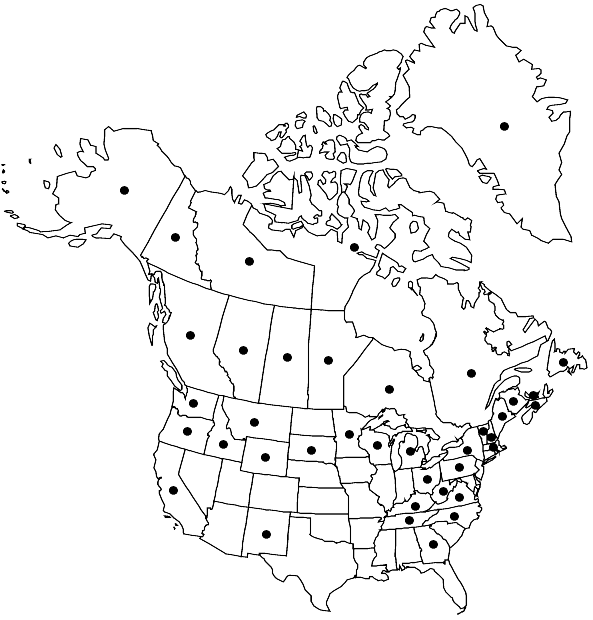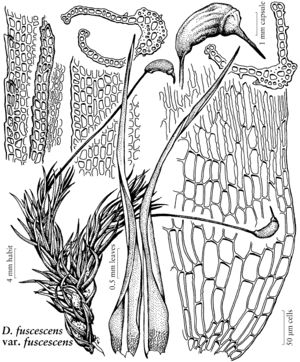Dicranum fuscescens var. fuscescens
Plants in loose tufts. Stems 1–6(–10) cm, tomentose with white or reddish brown rhizoids. Leaves falcate-secund, usually densely foliate; margins serrulate to strongly serrate in distal half; costa papillose to spinose distally on adaxial surface; proximal leaf cells elongate, pitted, (25–)43–62(–93) × (2–)6–8(–12) µm; distal laminal cells short-rectangular to quadrate, not pitted, (8–)18–23(–31) × (5–)8–12(–14) µm. Seta 1–3.5 cm.
Phenology: Capsules mature spring.
Habitat: Coniferous or deciduous tree trunks and bases of trees, rotten logs, stumps, soil, boulders, rock outcrops, cliff shelves, and humus in woodlands, or sometimes bogs
Elevation: 10-2300 m
Distribution

Greenland, Alta., B.C., Man., N.B., Nfld. and Labr. (Nfld.), N.W.T., N.S., Nunavut, Ont., P.E.I., Que., Sask., Yukon, Alaska, Calif., Ga., Idaho, Ky., Maine, Mass., Mich., Minn., Mont., N.H., N.Mex., N.Y., N.C., Ohio, Oreg., Pa., S.Dak., Tenn., Vt., Va., Wash., W.Va., Wis., Wyo., Europe, Asia.
Discussion
Variety fuscescens is highly variable but is best recognized by the loose tufts of green to brownish green, dull plants, the slender, falcate-secund leaves ending in a slender, keeled subula, slightly to strongly crisped when dry, the strongly serrated, often 2-stratose distal leaf margins, the excurrent costa that is conspicously rough above with papillae and spines on the abaxial surface, the nonpitted, short-rectangular, quadrate or irregularly angled distal leaf cells, and the solitary, often strumose, capsules that are inclined to horizontal.
Some plants of var. fuscescens, especially those in the northern part of Canada, may be confused with Dicranum acutifolium. The latter, however, usually has a few undulations on the leaves and the leaf cross section often reveals larger, more rounded bulging cell walls between the lamina cells and fewer 2-stratose regions on the margins than D. fuscescens. Dicranum sulcatum, considered a synonym by R. S. Williams (1913), has been recognized by W. L. Peterson (1979) as a distinct species. The diagnostic features are duller color due to a greater degree of papillosity, long-excurrent costa, wider costa at mid leaf, and presence of more rows of stereid cells, 3–5 rows compared to 2–3 rows in D. fuscescens. Dicranum sulcatum is reported to occur usually on living coniferous trees in the Pacific Northwest, from southern Alaska south to central California, inland to northern Idaho and northwestern Montana. All of the diagnostic characters are too variable to be important in maintaining that species. Furthermore, they are all quantitative characters, which makes it difficult to establish a distinct species without at least one good qualitative character. Further studies could help to establish it as a variety.
Variety fuscescens has been reported from Kentucky by J. A. Snider et al. (1988), Massachusetts by F. J. Hilferty (1960) and Ohio by Snider and B. K. Andreas (1996).
Selected References
None.
